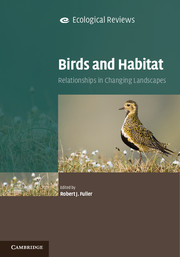Book contents
- Frontmatter
- Contents
- List of Contributors
- Preface
- Part I The complexity of patterns and processes
- Part II Case studies of habitat use and selection
- Part III Wider perspectives
- Chapter Fifteen What is habitat quality? Dissecting a research portfolio on shorebirds
- Chapter Sixteen Understanding individual life-histories and habitat choices: implications for explaining population patterns and processes
- Chapter Seventeen Insufficient adaptation to climate change alters avian habitat quality and thereby changes habitat selection
- Chapter Eighteen Australian birds in a changing landscape: 220 years of European colonisation
- Chapter Nineteen Birds in cultural landscapes: actual and perceived differences between northeastern North America and western Europe
- Chapter Twenty Birds and their changing habitat: thoughts on research and conservation strategies
- Species index
- Subject index
- References
Chapter Fifteen - What is habitat quality? Dissecting a research portfolio on shorebirds
Published online by Cambridge University Press: 05 December 2012
- Frontmatter
- Contents
- List of Contributors
- Preface
- Part I The complexity of patterns and processes
- Part II Case studies of habitat use and selection
- Part III Wider perspectives
- Chapter Fifteen What is habitat quality? Dissecting a research portfolio on shorebirds
- Chapter Sixteen Understanding individual life-histories and habitat choices: implications for explaining population patterns and processes
- Chapter Seventeen Insufficient adaptation to climate change alters avian habitat quality and thereby changes habitat selection
- Chapter Eighteen Australian birds in a changing landscape: 220 years of European colonisation
- Chapter Nineteen Birds in cultural landscapes: actual and perceived differences between northeastern North America and western Europe
- Chapter Twenty Birds and their changing habitat: thoughts on research and conservation strategies
- Species index
- Subject index
- References
Summary
It is intriguing that the fourth edition of the main British ecology textbook Ecology: From Individuals to Ecosystems (Begon et al., 2006) does not include habitat selection or habitat choice amongst the keywords in the subject index. What can be found is the word niche. Of course, this concept is closely bound up with the concepts related to the use and selection of habitats, as discussed in the present book. Nevertheless, Begon et al. (2006, p. 31) have interesting things to say about the relationships between the niche concept and the use of habitat, so let’s start with a citation: ‘The term ecological niche . . . is often used loosely to describe the sort of place in which an organism lives, as in the sentence: “Woodlands are the niche of woodpeckers”. Strictly, however, where an organism lives is its habitat. A niche is not a place but an idea: a summary of the organism’s tolerances and requirements. The habitat of a gut micro-organism would be an animal’s alimentary canal; the habitat of an aphid might be a garden; and the habitat of a fish could be a whole lake. Each habitat, however, provides many different niches: many other organisms also live in the gut, the garden or the lake – and with quite different lifestyles.’
This chapter presents a rather personal account of the attempts by myself and co-workers to explain the distribution and abundance of shorebirds, especially during the non-breeding season. We have tried to explain why non-breeding shorebirds use certain mudflats more than others, and why different individuals may use the same area in such different ways. In addition to the population and individual levels, we have also addressed questions on habitat selection at the species level, such as why some shorebird species use coastal rather than freshwater wetlands during the non-breeding season, and why some shorebird species breed on High Arctic tundra rather than in temperate grasslands (a behaviour that condemns them to very long migrations to escape the polar winters).
- Type
- Chapter
- Information
- Birds and HabitatRelationships in Changing Landscapes, pp. 383 - 407Publisher: Cambridge University PressPrint publication year: 2012
References
- 41
- Cited by

